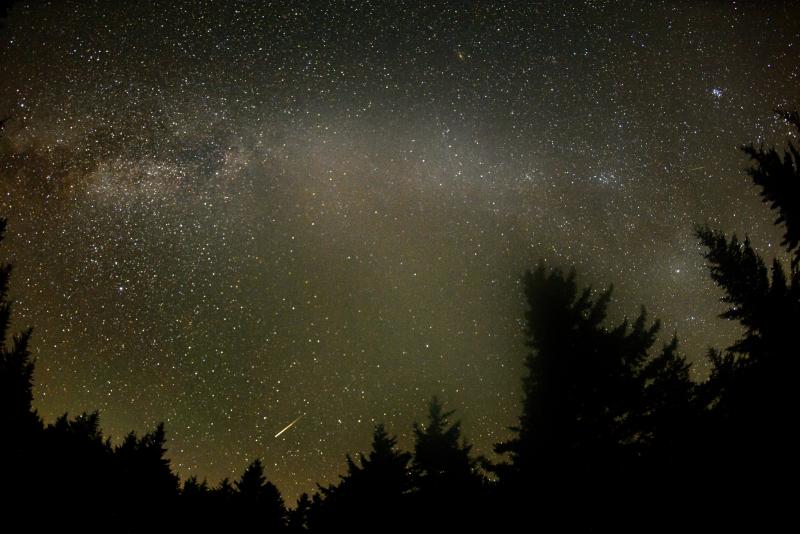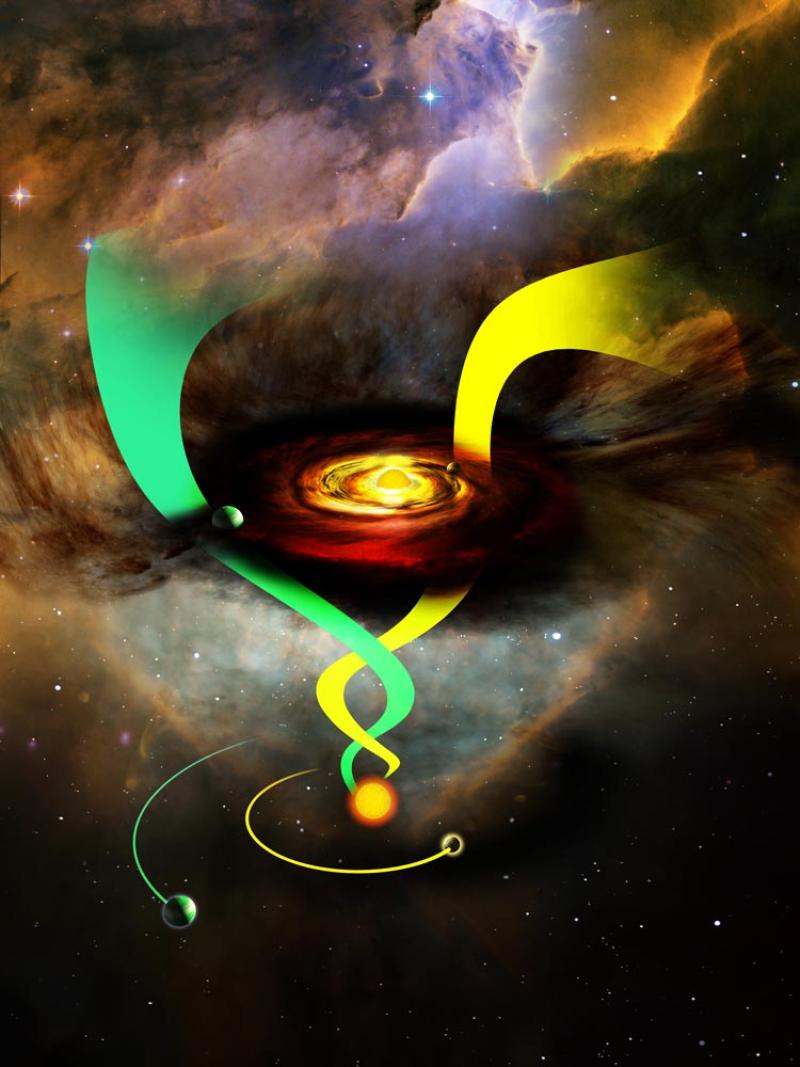UVA Astronomers Play A Starring Role at National Astronomical Meeting

From extrasolar planets to colossal stars to an infrared light mystery, University of Virginia astronomers presented their research at this month’s annual meeting of the American Astronomical Society in National Harbor, Maryland, and recently in leading journals. Also, an incoming UVA astronomer, Ilse Cleeves, earned an award for her promising research.
Here are a few samples of the presented discoveries.
Star Chemistry’s Effects on Planets
Astronomers have learned that the chemical composition of a star can exert unexpected influence on its planetary system – a discovery made possible by an ongoing Sloan Digital Sky Survey of stars seen by NASA’s Kepler spacecraft – and that promises to expand understanding of how extrasolar planets (planets in solar systems other than our own) form and evolve.
Using Sloan data, Robert Wilson, a UVA graduate student in astronomy and the lead author of a paper, along with an international team of researchers, found that stars with higher concentrations of iron tend to host planets that orbit quite close to their host star – often with orbital periods of less than about eight days – while stars with less iron tend to host planets with longer periods that are more distant from their host star.

“Without detailed and accurate measurements of the iron content of stars, we could have never made this measurement,” Wilson said. Further investigation of this effect, he noted, may help astronomers understand the full variety of extrasolar planetary systems in the Milky Way, and shed light on why planets are located where they are.
The story of planets around sun-like stars began in 1995, when a team of astronomers discovered a single planet orbiting a sun-like star 50 light-years from Earth. The pace of discovery accelerated in 2009, when NASA launched the Kepler spacecraft, a space telescope designed to look for extrasolar planets. During its four-year primary mission, Kepler monitored thousands of stars at a time, watching for the tiny dimming of starlight that indicates a planet passing in front its host star.
Because Kepler looked at the same stars for years, it saw their planets over and over again, and was thus able to measure the time the planet takes to orbit its star. This information reveals the distance from star to planet, with closer planets orbiting more often than farther ones. Thanks to Kepler’s monitoring, the number of extrasolar planets with known orbital periods dramatically increased from about 400 in 2009 to more than 3,000 today.
Although Kepler was perfectly designed to spot extrasolar planets, it was not designed to learn about the chemical compositions of the stars around which those planets orbit. That knowledge comes from the Sloan Digital Sky Survey’s Apache Point Observatory Galactic Evolution Experiment, or APOGEE, which has studied hundreds of thousands of stars all over the Milky Way. APOGEE, a unique, state-of-the-art instrument designed and built by researchers in the UVA astronomy department. It works by collecting a spectrum for each star – a measurement of how much light the star gives off at different wavelengths (colors). Because atoms of each chemical element interact with light in their own characteristic way, a spectrum allows astronomers to determine not only which elements a star contains, but also how much – for all elements including the key element iron.
By combining data from the two sources – planetary orbits from Kepler and stellar chemistry from APOGEE – astronomers have learned about the relationships between these “iron-enriched” stars and the planetary systems they hold.
What is particularly surprising about the new result, Wilson said, is that the iron-rich stars have only about 25 percent more iron than the others in the sample. “That’s like adding five-eighths of a teaspoon of salt into a cupcake recipe that calls for half a teaspoon of salt, among all its other ingredients. I’d still eat that cupcake!” he says. “That really shows us how even small differences in stellar composition can have profound impacts on planetary systems.”
But even with this new discovery, astronomers are left with many unanswered questions about how extrasolar planets form and evolve, especially those that are Earth-sized or slightly larger (“super-Earths”). Do iron-rich stars intrinsically form planets with shorter orbits? Or are planets orbiting iron-rich stars more likely to form farther out and then migrate to closer-in orbits? Wilson and collaborators hope to work with other astronomers to create new models of protoplanetary disks to test both of these explanations.
Unraveling Births of Colossal Stars
Astronomers are observing star-forming regions in our galaxy with NASA’s flying telescope, the Stratospheric Observatory for Infrared Astronomy, or SOFIA, to understand the processes and environments required to create the largest known stars, which tip the scales at 10 times or more the mass of our own sun.
UVA astronomer Jonathan Tan served on a research team that published, in The Astrophysical Journal, observations of eight extremely massive young stars located within our Milky Way galaxy. SOFIA’s powerful Faint Object infraRed Camera allowed the team to probe warm, dusty regions that are heated by light from luminous, massive stars that are still forming.
SOFIA’s location, above more than 99 percent of Earth’s infrared-blocking water vapor, coupled with its powerful instruments, make it the only observatory that can study the stars at the wavelengths, sensitivity and resolution necessary to see inside the dense dust clouds from which these stars are born.
The research is part of the ongoing SOFIA Massive Star Formation Survey by Tan and his collaborators, including UVA graduate student Mengyao Liu, who conducts data analysis. As part of this survey, they are studying a large sample of newborn stars, known as “protostars,” that have different masses, are at varying evolutionary stages, and within different environments. The team hopes to gain insight into the overall process of how massive stars form and to help test and refine new theoretical models of star formation.
“Understanding the birth process of massive stars is one of the most important unsolved problems of modern astrophysics, since these stars are so influential throughout our galaxy and beyond,” Tan said. “The unique ability of the SOFIA telescope to see at infrared wavelengths – wavelengths that are 100 times longer than those of visible light – is crucial for progress on this research, since this is the part of the spectrum where the stars emit most of their energy. Our recent and upcoming observations will yield a large enough sample to discover the general principles of how massive stars are born.”
Astronomers Find Key to Infrared Light Mystery
Astronomers had a mystery on their hands. No matter where they looked, from inside the Milky Way to distant galaxies, they observed a puzzling glow of infrared light. This faint cosmic light, which presents itself as a series of spikes in the infrared spectrum, had no easily identifiable source, though it is associated with such cosmic features as giant interstellar clouds, star-forming regions and supernova remnants. It is ubiquitous, and therefore challenging for astronomers to tease out its source.
Now, investigators may have solved the mystery by analyzing the light’s molecular make-up, using the Green Bank Radio Telescope in West Virginia. One of those astronomers is UVA doctoral fellow Andrew Burkhardt, who presented the findings at the AAS meeting. The results also were published in the journal Science.
Burkhardt and his colleagues have learned that polycyclic aromatic hydrocarbons, or PAHs – the proposed source of the infrared light – can be studied by searching for simpler precusor aromatic molecules, such as benzonitrile. While PAHs are very difficult to individually detect in space, benzonitrile can be sorted out, though it’s a challenging job. The research team accomplished this, though, and thereby made the first-ever detection of benzonitrile using radio astronomy, which detects chemical signatures emanating from space.
This detection may finally provide the “smoking gun” – that polycyclic aromatic hydrocarbons are spread throughout interstellar space and account for the mysterious infrared light astronomers had been observing for decades.
Using state-of-the-art computer models, the team simulated the chemical evolution of the Taurus constellation molecular cloud over a million-year period in an attempt to explain how benzonitrile could have formed in the extreme conditions of interstellar space. Detections such as this give chemists valuable clues that can help improve computer models of the universe and uncover new ways of making Earth-like compounds – possibly even the building block of life.
The science team was led by chemist Brett McGuire at the National Radio Astronomy Observatory in Charlottesville, a research entity of the National Science Foundation that has long, close collaborations with UVA’s astronomy department. Additionally, Chris Shingledecker, a UVA graduate student in chemistry, helped with the computational modeling of the chemistry. NRAO scientist Anthony Remijan, Burkhardt’s adviser, also contributed, as did Eric Herbst, a UVA professor of astronomy and chemistry.
Newly Hired Astronomer Wins Prestigious Award
Incoming UVA astronomy faculty member Ilse Cleeves, who arrives on Grounds in August, received the Annie Jump Cannon Award of the American Astronomical Society for “her groundbreaking work on planet formation and protoplanetary disks. She has established herself as an expert in astrochemical signatures in circumstellar disks.”
The award, given for outstanding research and promise for future research by a postdoctoral woman researcher, is given to a North American female astronomer within five years of receiving her Ph.D.
Cleeves currently is a postdoctoral fellow at the Harvard-Smithsonian Center for Astrophysics in Cambridge, Massachusetts. She earned her Ph.D. at the University of Michigan.




